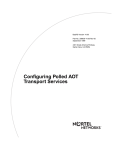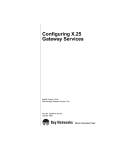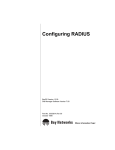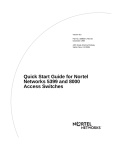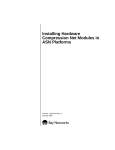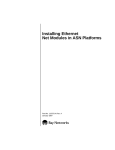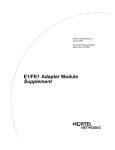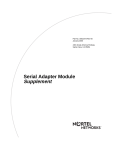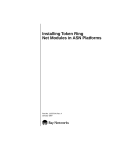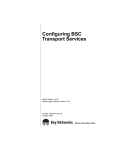Download Avaya Configuring Polled AOT Transport Services User's Manual
Transcript
Configuring Polled AOT
Transport Services
BayRS Version 13.00
Site Manager Software Version 7.00
Part No. 303536-A Rev 00
October 1998
4401 Great America Parkway
Santa Clara, CA 95054
8 Federal Street
Billerica, MA 01821
Copyright © 1998 Bay Networks, Inc.
All rights reserved. Printed in the USA. October 1998.
The information in this document is subject to change without notice. The statements, configurations, technical data,
and recommendations in this document are believed to be accurate and reliable, but are presented without express or
implied warranty. Users must take full responsibility for their applications of any products specified in this document.
The information in this document is proprietary to Bay Networks, Inc.
The software described in this document is furnished under a license agreement and may only be used in accordance
with the terms of that license. A summary of the Software License is included in this document.
Trademarks
ACE, AFN, AN, BCN, BLN, BN, BNX, CN, FRE, LN, Optivity, PPX, Quick2Config, and Bay Networks are
registered trademarks and Advanced Remote Node, ANH, ARN, ASN, BayRS, BaySecure, BayStack, BayStream,
BCC, BCNX, BLNX, EZ Install, EZ Internetwork, EZ LAN, FN, IP AutoLearn, PathMan, RouterMan, SN, SPEX,
Switch Node, System 5000, and the Bay Networks logo are trademarks of Bay Networks, Inc.
Microsoft, MS, MS-DOS, Win32, Windows, and Windows NT are registered trademarks of Microsoft Corporation.
All other trademarks and registered trademarks are the property of their respective owners.
Restricted Rights Legend
Use, duplication, or disclosure by the United States Government is subject to restrictions as set forth in subparagraph
(c)(1)(ii) of the Rights in Technical Data and Computer Software clause at DFARS 252.227-7013.
Notwithstanding any other license agreement that may pertain to, or accompany the delivery of, this computer
software, the rights of the United States Government regarding its use, reproduction, and disclosure are as set forth in
the Commercial Computer Software-Restricted Rights clause at FAR 52.227-19.
Statement of Conditions
In the interest of improving internal design, operational function, and/or reliability, Bay Networks, Inc. reserves the
right to make changes to the products described in this document without notice.
Bay Networks, Inc. does not assume any liability that may occur due to the use or application of the product(s) or
circuit layout(s) described herein.
Portions of the code in this software product may be Copyright © 1988, Regents of the University of California. All
rights reserved. Redistribution and use in source and binary forms of such portions are permitted, provided that the
above copyright notice and this paragraph are duplicated in all such forms and that any documentation, advertising
materials, and other materials related to such distribution and use acknowledge that such portions of the software were
developed by the University of California, Berkeley. The name of the University may not be used to endorse or
promote products derived from such portions of the software without specific prior written permission.
SUCH PORTIONS OF THE SOFTWARE ARE PROVIDED “AS IS” AND WITHOUT ANY EXPRESS OR
IMPLIED WARRANTIES, INCLUDING, WITHOUT LIMITATION, THE IMPLIED WARRANTIES OF
MERCHANTABILITY AND FITNESS FOR A PARTICULAR PURPOSE.
In addition, the program and information contained herein are licensed only pursuant to a license agreement that
contains restrictions on use and disclosure (that may incorporate by reference certain limitations and notices imposed
by third parties).
ii
303536-A Rev 00
Bay Networks, Inc. Software License Agreement
NOTICE: Please carefully read this license agreement before copying or using the accompanying software or
installing the hardware unit with pre-enabled software (each of which is referred to as “Software” in this Agreement).
BY COPYING OR USING THE SOFTWARE, YOU ACCEPT ALL OF THE TERMS AND CONDITIONS OF
THIS LICENSE AGREEMENT. THE TERMS EXPRESSED IN THIS AGREEMENT ARE THE ONLY TERMS
UNDER WHICH BAY NETWORKS WILL PERMIT YOU TO USE THE SOFTWARE. If you do not accept these
terms and conditions, return the product, unused and in the original shipping container, within 30 days of purchase to
obtain a credit for the full purchase price.
1. License Grant. Bay Networks, Inc. (“Bay Networks”) grants the end user of the Software (“Licensee”) a personal,
nonexclusive, nontransferable license: a) to use the Software either on a single computer or, if applicable, on a single
authorized device identified by host ID, for which it was originally acquired; b) to copy the Software solely for backup
purposes in support of authorized use of the Software; and c) to use and copy the associated user manual solely in
support of authorized use of the Software by Licensee. This license applies to the Software only and does not extend
to Bay Networks Agent software or other Bay Networks software products. Bay Networks Agent software or other
Bay Networks software products are licensed for use under the terms of the applicable Bay Networks, Inc. Software
License Agreement that accompanies such software and upon payment by the end user of the applicable license fees
for such software.
2. Restrictions on use; reservation of rights. The Software and user manuals are protected under copyright laws.
Bay Networks and/or its licensors retain all title and ownership in both the Software and user manuals, including any
revisions made by Bay Networks or its licensors. The copyright notice must be reproduced and included with any
copy of any portion of the Software or user manuals. Licensee may not modify, translate, decompile, disassemble, use
for any competitive analysis, reverse engineer, distribute, or create derivative works from the Software or user manuals
or any copy, in whole or in part. Except as expressly provided in this Agreement, Licensee may not copy or transfer
the Software or user manuals, in whole or in part. The Software and user manuals embody Bay Networks’ and its
licensors’ confidential and proprietary intellectual property. Licensee shall not sublicense, assign, or otherwise
disclose to any third party the Software, or any information about the operation, design, performance, or
implementation of the Software and user manuals that is confidential to Bay Networks and its licensors; however,
Licensee may grant permission to its consultants, subcontractors, and agents to use the Software at Licensee’s facility,
provided they have agreed to use the Software only in accordance with the terms of this license.
3. Limited warranty. Bay Networks warrants each item of Software, as delivered by Bay Networks and properly
installed and operated on Bay Networks hardware or other equipment it is originally licensed for, to function
substantially as described in its accompanying user manual during its warranty period, which begins on the date
Software is first shipped to Licensee. If any item of Software fails to so function during its warranty period, as the sole
remedy Bay Networks will at its discretion provide a suitable fix, patch, or workaround for the problem that may be
included in a future Software release. Bay Networks further warrants to Licensee that the media on which the
Software is provided will be free from defects in materials and workmanship under normal use for a period of 90 days
from the date Software is first shipped to Licensee. Bay Networks will replace defective media at no charge if it is
returned to Bay Networks during the warranty period along with proof of the date of shipment. This warranty does not
apply if the media has been damaged as a result of accident, misuse, or abuse. The Licensee assumes all responsibility
for selection of the Software to achieve Licensee’s intended results and for the installation, use, and results obtained
from the Software. Bay Networks does not warrant a) that the functions contained in the software will meet the
Licensee’s requirements, b) that the Software will operate in the hardware or software combinations that the Licensee
may select, c) that the operation of the Software will be uninterrupted or error free, or d) that all defects in the
operation of the Software will be corrected. Bay Networks is not obligated to remedy any Software defect that cannot
be reproduced with the latest Software release. These warranties do not apply to the Software if it has been (i) altered,
except by Bay Networks or in accordance with its instructions; (ii) used in conjunction with another vendor’s product,
resulting in the defect; or (iii) damaged by improper environment, abuse, misuse, accident, or negligence. THE
FOREGOING WARRANTIES AND LIMITATIONS ARE EXCLUSIVE REMEDIES AND ARE IN LIEU OF ALL
OTHER WARRANTIES EXPRESS OR IMPLIED, INCLUDING WITHOUT LIMITATION ANY WARRANTY OF
MERCHANTABILITY OR FITNESS FOR A PARTICULAR PURPOSE. Licensee is responsible for the security of
303536-A Rev 00
iii
its own data and information and for maintaining adequate procedures apart from the Software to reconstruct lost or
altered files, data, or programs.
4. Limitation of liability. IN NO EVENT WILL BAY NETWORKS OR ITS LICENSORS BE LIABLE FOR ANY
COST OF SUBSTITUTE PROCUREMENT; SPECIAL, INDIRECT, INCIDENTAL, OR CONSEQUENTIAL
DAMAGES; OR ANY DAMAGES RESULTING FROM INACCURATE OR LOST DATA OR LOSS OF USE OR
PROFITS ARISING OUT OF OR IN CONNECTION WITH THE PERFORMANCE OF THE SOFTWARE, EVEN
IF BAY NETWORKS HAS BEEN ADVISED OF THE POSSIBILITY OF SUCH DAMAGES. IN NO EVENT
SHALL THE LIABILITY OF BAY NETWORKS RELATING TO THE SOFTWARE OR THIS AGREEMENT
EXCEED THE PRICE PAID TO BAY NETWORKS FOR THE SOFTWARE LICENSE.
5. Government Licensees. This provision applies to all Software and documentation acquired directly or indirectly
by or on behalf of the United States Government. The Software and documentation are commercial products, licensed
on the open market at market prices, and were developed entirely at private expense and without the use of any U.S.
Government funds. The license to the U.S. Government is granted only with restricted rights, and use, duplication, or
disclosure by the U.S. Government is subject to the restrictions set forth in subparagraph (c)(1) of the Commercial
Computer Software––Restricted Rights clause of FAR 52.227-19 and the limitations set out in this license for civilian
agencies, and subparagraph (c)(1)(ii) of the Rights in Technical Data and Computer Software clause of DFARS
252.227-7013, for agencies of the Department of Defense or their successors, whichever is applicable.
6. Use of Software in the European Community. This provision applies to all Software acquired for use within the
European Community. If Licensee uses the Software within a country in the European Community, the Software
Directive enacted by the Council of European Communities Directive dated 14 May, 1991, will apply to the
examination of the Software to facilitate interoperability. Licensee agrees to notify Bay Networks of any such
intended examination of the Software and may procure support and assistance from Bay Networks.
7. Term and termination. This license is effective until terminated; however, all of the restrictions with respect to
Bay Networks’ copyright in the Software and user manuals will cease being effective at the date of expiration of the
Bay Networks copyright; those restrictions relating to use and disclosure of Bay Networks’ confidential information
shall continue in effect. Licensee may terminate this license at any time. The license will automatically terminate if
Licensee fails to comply with any of the terms and conditions of the license. Upon termination for any reason,
Licensee will immediately destroy or return to Bay Networks the Software, user manuals, and all copies. Bay
Networks is not liable to Licensee for damages in any form solely by reason of the termination of this license.
8. Export and Re-export. Licensee agrees not to export, directly or indirectly, the Software or related technical data
or information without first obtaining any required export licenses or other governmental approvals. Without limiting
the foregoing, Licensee, on behalf of itself and its subsidiaries and affiliates, agrees that it will not, without first
obtaining all export licenses and approvals required by the U.S. Government: (i) export, re-export, transfer, or divert
any such Software or technical data, or any direct product thereof, to any country to which such exports or re-exports
are restricted or embargoed under United States export control laws and regulations, or to any national or resident of
such restricted or embargoed countries; or (ii) provide the Software or related technical data or information to any
military end user or for any military end use, including the design, development, or production of any chemical,
nuclear, or biological weapons.
9. General. If any provision of this Agreement is held to be invalid or unenforceable by a court of competent
jurisdiction, the remainder of the provisions of this Agreement shall remain in full force and effect. This Agreement
will be governed by the laws of the state of California.
Should you have any questions concerning this Agreement, contact Bay Networks, Inc., 4401 Great America
Parkway, P.O. Box 58185, Santa Clara, California 95054-8185.
LICENSEE ACKNOWLEDGES THAT LICENSEE HAS READ THIS AGREEMENT, UNDERSTANDS IT, AND
AGREES TO BE BOUND BY ITS TERMS AND CONDITIONS. LICENSEE FURTHER AGREES THAT THIS
AGREEMENT IS THE ENTIRE AND EXCLUSIVE AGREEMENT BETWEEN BAY NETWORKS AND
LICENSEE, WHICH SUPERSEDES ALL PRIOR ORAL AND WRITTEN AGREEMENTS AND
COMMUNICATIONS BETWEEN THE PARTIES PERTAINING TO THE SUBJECT MATTER OF THIS
AGREEMENT. NO DIFFERENT OR ADDITIONAL TERMS WILL BE ENFORCEABLE AGAINST BAY
NETWORKS UNLESS BAY NETWORKS GIVES ITS EXPRESS WRITTEN CONSENT, INCLUDING AN
EXPRESS WAIVER OF THE TERMS OF THIS AGREEMENT.
iv
303536-A Rev 00
Contents
Preface
Before You Begin .............................................................................................................. xi
Text Conventions ..............................................................................................................xii
Acronyms .........................................................................................................................xiii
Bay Networks Technical Publications ..............................................................................xiii
How to Get Help ..............................................................................................................xiv
Chapter 1
Polled AOT Overview
Polled AOT Networking ...................................................................................................1-1
Polled AOT Configurations on Bay Networks Routers ....................................................1-3
Polled AOT Device Support ............................................................................................1-4
Chapter 2
Enabling Polled AOT
Starting Polled AOT on an Interface ...............................................................................2-2
Specifying the Polled AOT Interface Parameters ............................................................2-3
Creating the Polled AOT Peer Table ...............................................................................2-4
Completing the Configuration .........................................................................................2-7
Chapter 3
Editing Polled AOT Parameters
Editing the AOT Interface Parameters ............................................................................3-1
Editing the AOT Peer Table .............................................................................................3-3
Disabling the AOT Peer Table .........................................................................................3-4
Removing Polled AOT from the Router ...........................................................................3-5
303536-A Rev 00
v
Appendix A
Polled AOT Parameters
AOT Interface Parameters ............................................................................................. A-1
AOT Peer Table Parameters .......................................................................................... A-4
Asynchronous Parameters ............................................................................................ A-6
Index
vi
303536-A Rev 00
Figures
Figure 1-1.
Bay Networks Polled AOT Network Topology ..........................................1-2
Figure 2-1.
WAN Protocols Window ...........................................................................2-2
Figure 2-2.
Edit AOT Interface Window ......................................................................2-3
Figure 2-3.
AOT Peer Table Configuration Window ....................................................2-5
Figure 2-4.
Add AOT Peer Entry Window ...................................................................2-6
Figure 2-5.
Edit SYNC Parameters Window ...............................................................2-7
Figure 3-1.
AOT Interfaces Window ...........................................................................3-2
Figure 3-2.
AOT Peer Table Configuration Window ....................................................3-3
Figure 3-3.
Edit AOT Global Parameters Window ......................................................3-5
303536-A Rev 00
vii
Tables
Table 1-1.
303536-A Rev 00
Polled AOT Router and Module Support ..................................................1-3
ix
Preface
This guide describes how to customize Bay Networks® router software for polled
Asynchronous over TCP/IP (AOT) transport services.
Before You Begin
Before using this guide, you must complete the following procedures. For a new
router:
•
Install the router (see the installation guide that came with your router).
•
Connect the router to the network and create a pilot configuration file (see
Quick-Starting Routers, Configuring BayStack Remote Access, or Connecting
ASN Routers to a Network).
Make sure that you are running the latest version of Bay Networks BayRS™ and
Site Manager software. For information about upgrading BayRS and Site
Manager, see the upgrading guide for your version of BayRS.
303536-A Rev 00
xi
Configuring Polled AOT Transport Services
Text Conventions
This guide uses the following text conventions:
angle brackets (< >)
Indicate that you choose the text to enter based on the
description inside the brackets. Do not type the
brackets when entering the command.
Example: If the command syntax is:
ping <ip_address>, you enter:
ping 192.32.10.12
bold text
Indicates text that you need to enter and command
names and options.
Example: Enter show ip {alerts | routes}
Example: Use the dinfo command.
italic text
Indicates file and directory names, new terms, book
titles, and variables in command syntax descriptions.
Where a variable is two or more words, the words are
connected by an underscore.
Example: If the command syntax is:
show at <valid_route>
valid_route is one variable and you substitute one value
for it.
screen text
Indicates system output, for example, prompts and
system messages.
Example: Set Bay Networks Trap Monitor Filters
separator ( > )
Shows menu paths.
Example: Protocols > IP identifies the IP option on the
Protocols menu.
vertical line ( | )
Separates choices for command keywords and
arguments. Enter only one of the choices. Do not type
the vertical line when entering the command.
Example: If the command syntax is:
show ip {alerts | routes}, you enter either:
show ip alerts or show ip routes, but not both.
xii
303536-A Rev 00
Preface
Acronyms
AOT
Asynchronous over TCP/IP
CU
control unit
FEP
front-end processor
IP
Internet Protocol
TCP/IP
Transmission Control Protocol/Internet Protocol
WAN
wide area network
Bay Networks Technical Publications
You can now print Bay Networks technical manuals and release notes free,
directly from the Internet. Go to support.baynetworks.com/library/tpubs/. Find the
Bay Networks product for which you need documentation. Then locate the
specific category and model or version for your hardware or software product.
Using Adobe Acrobat Reader, you can open the manuals and release notes, search
for the sections you need, and print them on most standard printers. You can
download Acrobat Reader free from the Adobe Systems Web site,
www.adobe.com.
You can purchase Bay Networks documentation sets, CDs, and selected technical
publications through the Bay Networks Collateral Catalog. The catalog is located
on the World Wide Web at support.baynetworks.com/catalog.html and is divided
into sections arranged alphabetically:
•
The “CD ROMs” section lists available CDs.
•
The “Guides/Books” section lists books on technical topics.
•
The “Technical Manuals” section lists available printed documentation sets.
Make a note of the part numbers and prices of the items that you want to order.
Use the “Marketing Collateral Catalog description” link to place an order and to
print the order form.
303536-A Rev 00
xiii
Configuring Polled AOT Transport Services
How to Get Help
For product assistance, support contracts, or information about educational
services, go to the following URL:
http://www.baynetworks.com/corporate/contacts/
Or telephone the Bay Networks Technical Solutions Center at:
800-2LANWAN
xiv
303536-A Rev 00
Chapter 1
Polled AOT Overview
This chapter describes polled Asynchronous over TCP/IP (AOT) transport
services. It contains the following sections:
Section
Page
Polled AOT Networking
1-1
Polled AOT Configurations on Bay Networks Routers
1-3
Polled AOT Device Support
1-4
You should review this chapter if you are responsible for configuring polled AOT
on one or more Bay Networks routers. If you are already familiar with polled AOT
concepts, you can go directly to Chapter 2, “Enabling Polled AOT,” for
information about starting polled AOT on Bay Networks routers.
Polled AOT Networking
Polled AOT is a wide area network (WAN) protocol that enables transport of
asynchronous data packets over a TCP/IP network. Unlike synchronous
transmission, asynchronous transmission does not use clocking signals to time the
data transmission. Instead, asynchronous transmission uses start and stop bits to
control the transmission.
Polled AOT transmissions use TCP timers and keepalive settings to ensure that
there is an active TCP connection between two routers before any transmission
attempt. The router that you designate as the primary router transmits polls to a
secondary router over the active TCP connection. Because asynchronous
transmissions are relatively slow (300 b/s to 9600 b/s), polling ensures that the
secondary router is available for asynchronous transmission.
303536-A Rev 00
1-1
Configuring Polled AOT Transport Services
In one sample application (Figure 1-1), banks can use polled AOT to connect
alarm hosts to remote alarm panels. When an alarm host is connected to a local
Bay Networks router, the local router can establish a TCP/IP connection with a
remote router connected to an alarm panel. The local router receives the
asynchronous data packet from the alarm host and sends it over the TCP/IP
connection. When the remote router receives the packet, it strips the TCP/IP
information and forwards the alarm information to the alarm panel.
Figure 1-1 shows the Bay Networks polled AOT topology in a point-to-point
network.
Branch sites
Data center
Polled AOT
Bisync
server
Routers
Router
Bisync
terminal
Front end
processor
Async
alarm
panels
Async
alarm
host
CPS0001A
Figure 1-1.
1-2
Bay Networks Polled AOT Network Topology
303536-A Rev 00
Polled AOT Overview
Polled AOT Configurations on Bay Networks Routers
To configure a Bay Networks router for polled AOT, you use Site Manager’s
Configuration Manager on a PC or UNIX workstation. You configure polled AOT
on a port-by-port basis. Table 1-1 lists the router platforms and the modules that
support polled AOT.
Table 1-1.
Polled AOT Router and Module Support
AOT supported on these
modules
Router platform
Port labels
Access Node (AN®)
Any module that includes 2S
or 3S in the module name
COM1 to COM3
Access Stack Node (ASN™)
Dual Sync
Quad Sync
COM1, COM2
COM1 to COM4
Advanced Remote Node (ARN™)
Serial Adapter
TRI Serial Expansion
Ethernet/TRI Serial
Token Ring/TRI Serial
Ethernet/TRI Serial/DCM
COM2
COM3 to
COM3 to
COM3 to
COM3 to
Octal Sync
COM1 to COM8
Octal Sync
COM1 to COM8
Backbone Link Node-2 (BLN-2®)
Backbone Concentrator Node (BCN )
®
COM5
COM5
COM5
COM5
To create a polled AOT configuration, you must perform the following steps:
1.
Designate one router as the primary and the other router as the secondary.
In multipoint configurations, you can designate additional secondary routers.
2.
Configure a router AOT Peer Table, where you define which router (primary
or secondary) will initiate the TCP connection.
3.
Edit the polled AOT line parameters.
For details about starting polled AOT, see Chapter 2, “Enabling Polled AOT.”
303536-A Rev 00
1-3
Configuring Polled AOT Transport Services
Polled AOT Device Support
BayRS Version 12.0 supports polled AOT on the following alarm systems:
1-4
•
ADT (RS-232 Asynchronous Protocol)
•
Mosler 16 PT RTU
•
Mosler RTU 2000
303536-A Rev 00
Chapter 2
Enabling Polled AOT
This chapter describes how to enable polled AOT. It assumes that you have read
Configuring and Managing Routers with Site Manager and completed the
following steps:
1.
Opened a configuration file
2.
Specified the router hardware, if this is a local-mode configuration file
3.
Selected the connector on which you are enabling polled AOT
You enable polled AOT on your Bay Networks router by configuring it on each
interface you want to use for polled AOT transmissions. When you enable polled
AOT, you must specify certain parameters; the Configuration Manager supplies
default values for the other parameters. If you want to edit parameters, see
Chapter 3, “Editing Polled AOT Parameters.” Appendix A describes the polled
AOT parameters.
This chapter contains the following sections:
303536-A Rev 00
Section
Page
Starting Polled AOT on an Interface
2-2
Specifying the Polled AOT Interface Parameters
2-3
Creating the Polled AOT Peer Table
2-4
Completing the Configuration
2-7
2-1
Configuring Polled AOT Transport Services
Starting Polled AOT on an Interface
To start polled AOT on an interface, you begin at the WAN Protocols window
(Figure 2-1). The WAN Protocols window opens when you select the interface on
which you want to configure polled AOT.
Figure 2-1.
WAN Protocols Window
Site Manager Procedure
You do this
System responds
1. In the WAN Protocols window, select AOT.
2. Click on OK.
2-2
The Edit AOT Interface window opens
(Figure 2-2).
303536-A Rev 00
Enabling Polled AOT
Specifying the Polled AOT Interface Parameters
The Edit AOT Interface window (Figure 2-2) allows you to configure individual
interfaces for polled AOT transmissions. Specifically, you must perform the
following steps:
1.
Configure the interface to a primary or secondary router.
2.
Specify the type of interface: point-to-point or multipoint.
3.
Specify the TCP connection parameters.
Figure 2-2.
Edit AOT Interface Window
To configure a pair of routers to transmit polled AOT data, you designate one
router as the primary and the other router as the secondary. (For example, the
primary router is the one connected to the alarm host.)
Use the Interface Attached To parameter to specify whether the router you are
configuring is a primary or secondary router. The primary router transmits polls to
a secondary router over the active TCP connection. The secondary router receives
and responds to polls from the primary router.
303536-A Rev 00
2-3
Configuring Polled AOT Transport Services
Use the Interface Type parameter to specify whether the interface has one or many
TCP connections. Point-to-point provides one TCP connection to the peer router.
Multipoint provides many TCP connections to one or more peer routers. A
multipoint connection can also be one TCP connection to multiple peer routers. A
primary interface can have either a point-to-point or multipoint connection. A
secondary interface can have only a point-to-point connection to the primary
router.
Polled AOT transmissions use TCP timers and keepalive settings to ensure that
there is an active TCP connection between two routers before any transmission
attempt. Because asynchronous transmissions are relatively slow (300 b/s to
9600 b/s), polling ensures that the secondary router is available for asynchronous
transmission.
Site Manager Procedure
You do this
System responds
1. In the Edit AOT Interface window, edit the
following parameters:
• Enable
• Interface Attached To
• Interface Type
• TCP Keepalive Int
• TCP Keepalive Retry Timeout
• TCP Keepalive Retry Count
Click on Help or see the parameter
descriptions beginning on page A-1.
2. Click on OK.
The AOT Peer Table Configuration
window opens (Figure 2-3).
Creating the Polled AOT Peer Table
This section explains how to set up the AOT Peer Table, which directs packets to a
specific port. The AOT Peer Table contains the following information:
•
The IP address of the remote peer router
•
The router that will initiate the connection
•
The TCP listen port address of the local or remote peer router
You create the AOT Peer Table using the AOT Peer Table Configuration window
(Figure 2-3).
2-4
303536-A Rev 00
Enabling Polled AOT
Figure 2-3.
AOT Peer Table Configuration Window
Site Manager Procedure
You do this
System responds
1. In the AOT Peer Table Configuration
window, click on Add.
The Add AOT Peer Entry window opens
(Figure 2-4).
2. In the Add AOT Peer Entry window, edit
the following parameters:
• Peer IP Address
• Connection Originator
• Local TCP Listen Port
• Peer TCP Listen Port
Click on Help or see the parameter
descriptions beginning on page A-4.
3. Click on OK.
The AOT Peer Table Configuration
window opens, displaying the AOT Peer
Table entry you just added.
4. Click on Add to specify additional peers if
this is a multipoint configuration, then edit
the parameters from step 2. Click on OK
when you are finished.
(continued)
303536-A Rev 00
2-5
Configuring Polled AOT Transport Services
Site Manager Procedure (continued)
You do this
System responds
5. Select an entry and click on Delete to
remove it from the AOT Peer Table.
The entry disappears from the AOT Peer
Table Configuration window.
6. Click on Done.
The Configuration Manager window
opens.
Figure 2-4.
Add AOT Peer Entry Window
In the AOT Peer Table, you use the Connection Originator parameter to define
which router (primary or secondary) will initiate the TCP connection. You set the
Connection Originator parameter to the local router (Self) or the remote peer
router (Partner).
If the primary router is initiating the connection, you specify the IP address and
TCP port number of the remote peer router. If the secondary router is initiating the
connection, you specify the IP address and port number of the local TCP listen
port.
2-6
303536-A Rev 00
Enabling Polled AOT
Completing the Configuration
To complete the polled AOT configuration, you must set the WAN serial interface
type to asynchronous transmission. You set the WAN Serial Interface Type
parameter using the Edit SYNC Parameters window (Figure 2-5).
Figure 2-5.
Edit SYNC Parameters Window
Site Manager Procedure
You do this
System responds
1. In the Configuration Manager window,
click on the interface you want to edit.
The Edit Connector window opens.
2. In the Edit Connector window, click on
Edit Line.
The Edit SYNC Parameters window
opens (Figure 2-5).
3. Scroll down to the WAN Serial Interface
Type parameter. Click on Values and
select PASYNC. Click on Help or see the
parameter description on page A-6.
(continued)
303536-A Rev 00
2-7
Configuring Polled AOT Transport Services
Site Manager Procedure (continued)
You do this
System responds
4. Click on OK.
The Edit Connector window opens.
5. Click on Done.
The Configuration Manager window
opens.
You can also edit the Pasync Parity Type, Pasync Data Bits, Pasync Stop Bits, and
Pasync Baud Rate parameters from the Edit SYNC Parameters window. See
Appendix A for information about these parameters.
2-8
303536-A Rev 00
Chapter 3
Editing Polled AOT Parameters
After you configure polled AOT for the first time, you may need to edit the AOT
interface or AOT Peer Table parameters. The following sections describe how to
edit a polled AOT configuration:
Section
Page
Editing the AOT Interface Parameters
3-1
Editing the AOT Peer Table
3-3
Disabling the AOT Peer Table
3-4
Removing Polled AOT from the Router
3-5
Editing the AOT Interface Parameters
This section describes how to edit the AOT interface parameters from the AOT
Interfaces window (Figure 3-1).
303536-A Rev 00
3-1
Configuring Polled AOT Transport Services
Figure 3-1.
AOT Interfaces Window
Site Manager Procedure
You do this
System responds
1. In the Configuration Manager window,
choose Protocols > AOT > Interfaces.
The AOT Interfaces window opens
(Figure 3-1).
2. In the AOT Interfaces window, edit the
following parameters:
• Enable
• Interface Attached To
• Interface Type
• TCP Keepalive Int
• TCP Keepalive Retry Timeout
• TCP Keepalive Retry Count
Click on Help or see the parameter
descriptions beginning on page A-1.
(continued)
3-2
303536-A Rev 00
Editing Polled AOT Parameters
Site Manager Procedure (continued)
You do this
System responds
3. Click on Apply to save your changes.
4. Click on Done.
The Configuration Manager window
opens.
Editing the AOT Peer Table
This section describes how to edit the AOT Peer Table from the AOT Peer Table
Configuration window (Figure 3-2). The AOT Peer Table contains the remote
peer’s IP address and port information.
Figure 3-2.
303536-A Rev 00
AOT Peer Table Configuration Window
3-3
Configuring Polled AOT Transport Services
Site Manager Procedure
You do this
System responds
1. In the AOT Interfaces window (Figure 3-1), The AOT Peer Table Configuration
select an entry and click on Peer Table.
window opens (Figure 3-2).
2. Click on Add to specify additional peers if
this is a multipoint configuration.
The Add AOT Peer Entry window opens
(Figure 2-4 on page 2-6).
3. In the Add AOT Peer Entry window, edit
the following parameters:
• Peer IP Address
• Connection Originator
• Local TCP Listen Port
• Peer TCP Listen Port
Click on Help or see the parameter
descriptions beginning on page A-4.
4. Click on OK.
The AOT Peer Table Configuration
window opens, displaying the AOT Peer
Table entry you just added.
5. Select an entry and click on Delete to
remove it from the AOT Peer Table.
The entry disappears from the AOT Peer
Table Configuration window.
6. When you are finished, click on Done.
The AOT Interfaces window opens.
7. Click on Apply to save your changes.
8. Click on Done.
The Configuration Manager window
opens.
Disabling the AOT Peer Table
If you want to stop TCP data transmissions to a peer router, you disable the
router’s AOT Peer Table from the Edit AOT Global Parameters window
(Figure 3-3).
3-4
303536-A Rev 00
Editing Polled AOT Parameters
Figure 3-3.
Edit AOT Global Parameters Window
Site Manager Procedure
You do this
System responds
1. In the Configuration Manager window,
choose Protocols > AOT > Global.
The Edit AOT Global Parameters window
opens (Figure 3-3).
2. Click on Values.
The Values Selection window opens.
3. Select Disable.
4. Click on OK.
The Configuration Manager window
opens.
Removing Polled AOT from the Router
Site Manager allows you to remove a polled AOT configuration from the router.
When you remove a polled AOT configuration, Site Manager removes it from all
interfaces you have configured for polled AOT.
Site Manager Procedure
303536-A Rev 00
You do this
System responds
1. In the Configuration Manager window,
choose Protocols > AOT > Delete AOT.
A dialog box opens, displaying the
prompt, “Do you really want to delete
AOT?”
2. Click on OK.
Site Manager removes polled AOT from
the router and the Configuration Manager
window opens.
3-5
Appendix A
Polled AOT Parameters
AOT Interface Parameters
Parameter: Enable
Path:
Default:
Options:
Function:
Instructions:
Configuration Manager > Protocols > AOT > Interfaces
Enable
Enable | Disable
Enables or disables polled AOT on an interface.
Select Enable to run polled AOT on this interface. Select Disable to stop polled
AOT services on this interface.
MIB Object ID: 1.3.6.1.4.1.18.3.5.21.2.1.2
Parameter: Interface Attached To
Path:
Default:
Options:
Function:
Configuration Manager > Protocols > AOT > Interfaces
0
Primary | Secondary
Specifies whether this interface connects to a host (primary connection) or a
control unit (secondary connection).
Instructions: Select Primary or Secondary.
MIB Object ID: 1.3.6.1.4.1.18.3.5.21.2.1.7
303536-A Rev 00
A-1
Configuring Polled AOT Transport Services
Parameter: Interface Type
Path:
Default:
Options:
Function:
Configuration Manager > Protocols > AOT > Interfaces
None
Point-to-Point | Multipoint
Specifies whether the interface has one or many TCP connections.
Point-to-point provides one TCP connection to the peer router. Multipoint
provides many TCP connections to one or more peer routers. A multipoint
connection can also be one TCP connection to multiple control units (CUs). A
primary interface can have either a point-to-point or multipoint connection. A
secondary interface can have only a point-to-point connection.
Instructions: If this is a primary interface, select Point-to-Point or Multipoint; if this is a
secondary interface, select Point-to-Point.
MIB Object ID: 1.3.6.1.4.1.18.3.5.21.2.1.6
Parameter: TCP Keepalive Int (sec)
Path:
Default:
Options:
Function:
Configuration Manager > Protocols > AOT > Interfaces
120
0 to 86400 seconds
Specifies how often the local router sends a signal to the remote peer router to
verify that the peer router is working correctly and can receive messages.
If the remote peer router does not acknowledge a keepalive packet, the local
router retransmits the keepalive packet. You should set the keepalive interval
based on the total time it takes to send and receive acknowledgment from the
remote peer router.
Since keepalive packets are sent only on idle lines, increasing the keepalive
interval may decrease the cost of an idle network. For busy networks, the
keepalive interval is not necessary because frequent TCP transmissions perform
the same function as a keepalive interval.
Instructions: Specify an appropriate value for the network. Bay Networks recommends that
you set this parameter to the same value as the remote peer router to maintain
synchronization.
MIB Object ID: 1.3.6.1.4.1.18.3.5.21.2.1.9
A-2
303536-A Rev 00
Polled AOT Parameters
Parameter: TCP Keepalive Retry Timeout (sec)
Path:
Default:
Options:
Function:
Configuration Manager > Protocols > AOT > Interfaces
4
0 to 600 seconds
Specifies the maximum amount of time between each successive retransmission
of keepalive packets. If the local router does not receive an acknowledgment
within the TCP keepalive retry timeout, it retransmits the keepalive packet. The
router continues to retransmit the keepalive packet at every TCP keepalive retry
timeout until it receives an acknowledgment from the remote peer router, or
until TCP reaches the keepalive retry count setting.
Instructions: Specify a value in the range 0 to 600.
MIB Object ID: 1.3.6.1.4.1.18.3.5.21.2.1.10
Parameter: TCP Keepalive Retry Count
Path:
Default:
Options:
Function:
Configuration Manager > Protocols > AOT > Interfaces
5
0 to 99 seconds
Specifies the number of times that TCP attempts to establish or maintain a
connection. If TCP does not receive an acknowledgment after a series of retries,
TCP makes no additional attempts to establish a connection.
Instructions: Specify a value in the range 0 to 99 seconds.
MIB Object ID: 1.3.6.1.4.1.18.3.5.21.2.1.11
303536-A Rev 00
A-3
Configuring Polled AOT Transport Services
AOT Peer Table Parameters
Parameter: Enable
Path:
Default:
Options:
Function:
Instructions:
MIB Object ID:
Configuration Manager > Protocols > AOT > Interfaces > Peer Table
Enable
Enable | Disable
Enables or disables the TCP connection to the remote peer router.
Select Enable or Disable.
1.3.6.1.4.1.18.3.5.21.3.1.2
Parameter: Peer IP Address
Path:
Default:
Options:
Function:
Instructions:
MIB Object ID:
Configuration Manager > Protocols > AOT > Interfaces > Peer Table > Add
None
Any valid IP address
Specifies the IP address of the peer router.
Specify the peer router’s IP address in dotted-decimal notation.
1.3.6.1.4.1.18.3.5.21.3.1.5
Parameter: Connection Originator
Path:
Default:
Options:
Function:
Configuration Manager > Protocols > AOT > Interfaces > Peer Table > Add
0
Self | Partner
Determines whether this router (Self) or the remote peer router (Partner)
initiates the TCP connection.
Instructions: Select Self or Partner. Specify the opposite value for this parameter on the other
router.
MIB Object ID: 1.3.6.1.4.1.18.3.5.21.3.1.6
A-4
303536-A Rev 00
Polled AOT Parameters
Parameter: Local TCP Listen Port
Path:
Default:
Options:
Function:
Configuration Manager > Protocols > AOT > Interfaces > Peer Table > Add
None
1000 to 9999
Specifies the local router’s TCP port number, which the remote peer router will
use to establish a TCP connection. This parameter is available only when you
set the Connection Originator parameter to Partner.
Instructions: Specify a valid, available port number for this router. Be sure to use the same
value for the Peer TCP Listen Port parameter on the remote peer router.
MIB Object ID: 1.3.6.1.4.1.18.3.5.18.3.1.7
Parameter: Peer TCP Listen Port
Path:
Default:
Options:
Function:
Configuration Manager > Protocols > AOT > Interfaces > Peer Table > Add
None
1000 to 9999
Specifies the remote peer router’s TCP port number, which the local router uses
to establish a TCP connection. This parameter is available only when you set the
Connection Originator parameter to Self.
Instructions: Specify a valid, available port number for the remote peer router. Be sure to use
the same value for the Local TCP Listen Port parameter on the local router.
MIB Object ID: 1.3.6.1.4.1.18.3.5.18.3.1.8
303536-A Rev 00
A-5
Configuring Polled AOT Transport Services
Asynchronous Parameters
Parameter: WAN Serial Interface Type
Path:
Default:
Options:
Function:
COM Connector > Edit Line > Edit SYNC Parameters
None
SYNC | ASYNC | PASYNC
Determines whether this interface uses synchronous, asynchronous, or polled
asynchronous communications.
Instructions: Click on Values and select SYNC, ASYNC, or PASYNC.
MIB Object ID: 1.3.6.1.4.1.18.3.4.5.1.109
Parameter: Pasync Parity Type
Path:
Default:
Options:
Function:
COM Connector > Edit Line > Edit SYNC Parameters
Even
Odd | Even | High | Low | None
Sets the error-detection method for isolating altered or damaged polled AOT
packets during transmission. Asynchronous equipment typically adds a parity
bit to the end of a packet before transmission. This allows the receiving router to
detect a transmission error if it receives a packet with an unexpected parity.
Instructions: Click on Values and select a value that is appropriate for your network.
MIB Object ID: 1.3.6.1.4.1.18.3.4.5.1.116
Parameter: Pasync Data Bits
Path:
Default:
Options:
Function:
Instructions:
MIB Object ID:
A-6
COM Connector > Edit Line > Edit SYNC Parameters
Eight
Five | Six | Seven | Eight
Sets the length of a polled AOT packet to a specific number of data bits.
Click on Values and select a value that is appropriate for your network.
1.3.6.1.4.1.18.3.4.5.1.117
303536-A Rev 00
Polled AOT Parameters
Parameter: Pasync Stop Bits
Path:
Default:
Options:
Function:
COM Connector > Edit Line > Edit SYNC Parameters
Two
One | Two
Sets the interval at the end of a transmitted polled AOT packet, allowing the
receiving router to pause before accepting the next packet. More stop bits create
a longer pause at the receiving router.
Instructions: Click on Values and select a value that is appropriate for your network.
MIB Object ID: 1.3.6.1.4.1.18.3.4.5.1.118
Parameter: Pasync Baud Rate
Path:
Default:
Options:
Function:
COM Connector > Edit Line > Edit SYNC Parameters
600
150 | 300 | 600 | 1200 | 2400 | 4800 | 9600 | 19200 | 38400 | 57600
Sets the speed for transmission of polled AOT packets between primary and
secondary routers over a TCP connection.
Instructions: Click on Values and select a baud rate that is appropriate for your network.
MIB Object ID: 1.3.6.1.4.1.18.3.4.5.1.119
303536-A Rev 00
A-7
Index
A
acronyms, xiii
AOT Peer Table parameters
Connection Originator, A-4
Enable, A-4
Local TCP Listen Port, A-5
Peer IP Address, A-4
Peer TCP Listen Port, A-5
asynchronous parameters
Pasync Baud Rate, A-7
Pasync Data Bits, A-6
Pasync Parity Type, A-6
Pasync Stop Bits, A-7
WAN Serial Interface Type, A-6, A-7
C
Configuration Manager, 1-2, 1-3
Connection Originator parameter, A-4
conventions, text, xii
E
educational services, xiv
Enable parameter
for local router, A-1
for remote peer router, A-4
I
Interface Attached To parameter, A-1
Interface Type parameter, A-2
L
P
Pasync Baud Rate parameter, A-7
Pasync Data Bits parameter, A-6
Pasync Parity Type parameter, A-6
Pasync Stop Bits parameter, A-7
Peer IP Address parameter, A-4
Peer TCP Listen Port parameter, A-5
polled Asynchronous over TCP/IP (AOT)
asynchronous parameters
Pasync Baud Rate, A-7
Pasync Data Bits, A-6
Pasync Parity Type, A-6
Pasync Stop Bits, A-7
WAN Serial Interface Type, A-6
device support, 1-4
disabling the Peer Table, 3-4
enabling on an interface, 2-2, 2-3, 2-4, 2-7
setting interface parameters, 2-3, 3-1
setting Peer Table parameters, 2-4, 3-3
setting the WAN serial interface type, 2-7
interface parameters
Enable, A-1
Interface Attached To, A-1
Interface Type, A-2
TCP Keepalive Int, A-2
TCP Keepalive Retry Count, A-3
TCP Keepalive Retry Timeout, A-3
overview, 1-1
Peer Table parameters
Connection Originator, A-4
Enable, A-4
Local TCP Listen Port, A-5
Peer IP Address, A-4
Peer TCP Listen Port, A-5
Local TCP Listen Port parameter, A-5
303536-A Rev 00
Index-1
polled Asynchronous over TCP/IP (AOT) (continued)
removing from Bay Networks routers, 3-5
router and module support, 1-3
product support, xiv
publications, Bay Networks, xiii
S
Site Manager, 1-3
support, Bay Networks, xiv
T
TCP Keepalive Int parameter, A-2
TCP Keepalive Retry Count parameter, A-3
TCP Keepalive Retry Timeout parameter, A-3
technical publications, xiii
technical support, xiv
text conventions, xii
W
WAN Serial Interface Type parameter, A-6
Index-2
303536-A Rev 00










































